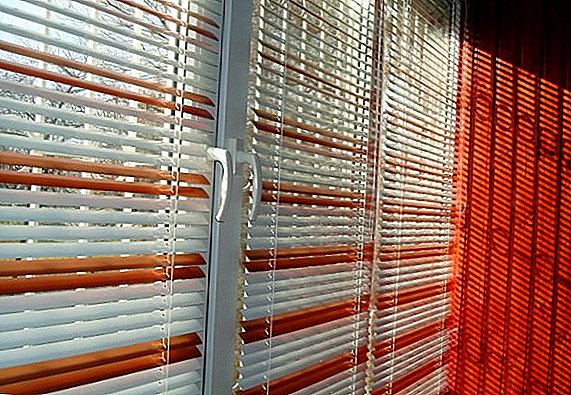 Not many people know that blinds were invented several centuries ago. Today it is one of the most popular decorative and protective devices for windows. The article will discuss how to independently hang the blinds on the plastic windows. You will be able to find out what types of multi-window window curtains are and how to properly install vertical and horizontal blinds.
Not many people know that blinds were invented several centuries ago. Today it is one of the most popular decorative and protective devices for windows. The article will discuss how to independently hang the blinds on the plastic windows. You will be able to find out what types of multi-window window curtains are and how to properly install vertical and horizontal blinds.
Kinds
Jalousie - one of the types of window curtains, the device in the form of rigid, parallel to each other and adjustable plates made of different materials - fabrics, wood, metal, plastic. They have several functions:
- protect from light;
- decorate the window;
- regulate air flow.
- horizontal;
- vertical;
- roll;
- pleated.

Did you know? The official history of the invention of blinds begins in 1841. That year, their production was patented by an American, John Hampton, although the production of hard curtains was carried out before. So, from the 1760s, they were released in Philadelphia by the Englishman John Webster.
Horizontal
Horizontal or Venetian blinds are thin plates (lamellae), which are located above each other on the type of ladder. They are interconnected by a cord that allows you to open and close them, as well as adjust the height. Management of plates occurs with the help of a rotating rod. Lamella can be made of different materials - wood, metal, bamboo, fabric.
The main advantages of these types of curtains are:
- good sun protection;
- increased heat emission;
- the ability to control the intensity of lighting;
- reliability;
- durability;
- ease of care and operation;
- the ability to visually expand the size of the room;
- easy installation;
- possibility of use for any premises, including kitchen, bath, balcony;
- low cost.

Learn how to insulate windows for the winter.
Vertical
Vertical blinds appeared a little later than horizontal - in 1960. Nevertheless, they quickly gained popularity and today are successfully used for decorating various premises.
These are plastic, metal or fabric lamellae, suspended on a cornice in a vertical position parallel to each other and connected at the bottom with a cord. They are regulated by a side mechanism that rotates the plates — they are turned with the help of a decorative lace (chain), shifted to one side with the help of a rope, fully or partially opening the window.
The advantages of vertical blinds are:
- versatility - the possibility of installation in window openings, to the ceiling, to the wall above the window, installation in the attic and ordinary windows;
- ease of installation;
- ease of care;
- effective regulation of the flow of sunlight;
- good access of air at blackout;
- possibility of combining with ordinary curtains;
- the ability to visually increase the height of the room.
- inconvenience when moving sideways when opening a window;
- the impossibility of placing flowers on the windowsill when fastening to the window opening.

Rolled
Roller blinds have recently entered the field of view of modern apartment design. Preference is given to those who love coziness and comfort in the house. They are able to create them in the bedroom, living room and kitchen. In addition, the appearance of the roller blinds is more attractive than other types, while the functionality also remains at a height.
They are designed in the form of a horizontal shaft on which a roll of fabric is wound, and a control mechanism in the form of a cord, a spring holder or an electric drive. The fabric can be lowered and raised to the desired length, completely or partially closing the window. Roller blinds are mounted in the window opening, on the ceiling or on the wall, on the window sash.
The advantages of roller blinds are:
- ease of operation;
- ease of care - the fabric is impregnated with a dust- and water-repellent compound;
- the possibility of translating any design idea;
- durability;
- good protection from sunlight and overheating of the room;
- the ability to create any degree of illumination of the room;
- environmental friendliness;
- ergonomics;
- possibility of installation on dormer-windows;
- when installed on each sash no interference for opening windows and decorating the window sill;
- the possibility of making curtains from transparent materials.
 The disadvantages include the price, which is much higher than that of more familiar and common horizontal and vertical structures, as well as the fragility of the spring holder.
The disadvantages include the price, which is much higher than that of more familiar and common horizontal and vertical structures, as well as the fragility of the spring holder.One type of roller blinds are cassette. This is an option designed for plastic windows. It is assumed that the slats or fabric roll when closing hide in a specially designed box (cassette) attached to the sash window.
This design allows to save space, free the window and window sill, additionally protect the material from dust, dirt, deformation. Cassette options are made of fabric, bamboo, aluminum, plastic. There are three types of cassettes: round, angled and flat. 
Pleated
One more option of blinds from fabric - pleated. As already follows from the name - it is fabric curtains, collected in a small fold. Their choice is huge and is represented by various colors, density of fabric material, forms. Some of them are sewn on a special pattern.
Thanks to this pleated curtains can fit into any interior, creating an original atmosphere. This option is a cut of fabric, which is mounted on a special profile and is controlled by a chain, lace or electric drive.
The advantages of pleated curtains:
- originality;
- visual appeal;
- good functionality;
- durability;
- reliability;
- miniature design;
- possibility of window decoration of any shape and from any material.
 Original and sophisticated solutions in the interior do not do without the use of multi-venetian blinds, i.e. those in which the slats are made of various materials using a variety of decor.
Original and sophisticated solutions in the interior do not do without the use of multi-venetian blinds, i.e. those in which the slats are made of various materials using a variety of decor.Varieties of material
As already mentioned, at different times, blinds were made from different textures. Today, the most common materials for hard window curtains are fabric, plastic and aluminum, less wood. Each of them has both pros and cons.
Pay attention to which indoor plants are advised for offices, bedrooms, nurseries, balconies.
Fabric
Textile blinds - This is one of the best options for decorating windows and protecting the room from sunlight in apartments and houses. There are both horizontal and vertical structures.
Many people are attracted by the appearance and a huge selection of colors for fabric blinds, but they are frightened by the opinion that they will need the same care as regular curtains. However, it is not.
Textiles for blinds are impregnated with special impregnations that prevent dirt, dust and moisture from being absorbed. Care will consist only of periodically wiping the material with a slightly damp cloth and vacuuming. High-quality textile blinds do not fade, do not deform, fit into any interior, are not too expensive. However, compared with metal, plastic and wooden structures have a shorter service life. Textile models are not the best option for the kitchen or catering, as they can absorb odors.
High-quality textile blinds do not fade, do not deform, fit into any interior, are not too expensive. However, compared with metal, plastic and wooden structures have a shorter service life. Textile models are not the best option for the kitchen or catering, as they can absorb odors.
Did you know? The first blinds were made of wooden plates. They were replaced by metal curtains. After World War II, fabrics were also used for the manufacture of window protective devices.
Plastic
One of the most purchased species, due to its low price and the possibility of using in various rooms - office, apartment, public, utility, with high humidity. The polymers of which the lamellae are made can be with varying degrees of light transmission, of various colors, with or without drawings. They are practical, lightweight, easy to install and maintain, they are sold at the best price. Among the disadvantages:
Among the disadvantages:
- creating noise in the draft, with open windows;
- some polymers turn yellow when exposed to sunlight;
- cannot be used near stoves and other heating devices due to poor resistance to fire;
- release of toxic substances in case of fire.
Aluminum
Along with plastic, aluminum blinds are also popular. They have high strength, durability, fire resistance, the ability to withstand different temperatures, moisture. Often used to protect windows in public places, offices, medical facilities. They have an attractive price. They can be horizontal, vertical, cassette.
Among the disadvantages - heavier weight, creating a sound effect when draft.
If you are going to make your home more comfortable, it is useful to learn how to remove paint from walls, how to remove whitewash, how to glue wallpaper, how to run water in a private house, how to put a wall outlet, how to make a plasterboard partition with a doorway, how to install a light switch, how to install a flowing water heater, how to sheathe plasterboard walls.
Wood
Wood blinds are used in certain types of interior, they are perfectly combined with fabric curtains and furniture made of natural wood. They allow you to create a warm, homely atmosphere. They are reliable, durable, durable, eco-friendly, well protected from the sun. At the same time are one of the most expensive options. 
Installation technology
Install blinds without the help of professionals. We offer you instructions for working with horizontal and vertical stiff curtains.
Horizontal
Horizontal constructions can be mounted in four ways:
- to the ceiling;
- to the wall above the window;
- in the window opening;
- to the sash.
When installing curtains in the window opening their size is calculated by weaning 1 cm from a height, 2 cm from a width.
When installed above the window opening the size of the blinds is calculated based on the addition to its height of 5-7 cm and to the width - 20 cm.
When fastening to the sash measured width from the joint of the bead with the window on the left side to the joint of the bead with the window on the right side, adding 1 cm.
When measuring height on a blank window to the distance from the glazing bead to the glazing bead is added 3 cm, on the leaf - 4 cm.
Video: how to measure horizontal blinds
Ordinary horizontal blinds consist of the following elements:
- upper part - swivel axle, rollers, cornice, brackets, cord retainer, swivel mechanism, upper cover;
- middle part - lamellae and cap;
- lower part - lower eaves, side covers.
- screwdriver;
- pencil;
- screws.
Learn how to build a cellar with ventilation, a sheepfold, a chicken coop, a veranda, a gazebo, a brazier, a pergola, a fence made of a chain-link, from gabions, a dry stream, a smokehouse of hot and cold smoked, a spil track, a concrete one, a waterfall, an alpine slide, a fountain, a fence , a bed of stones, a trellis with his own hands.
 The technology of installation of finished aluminum blinds on plastic windows is as follows:
The technology of installation of finished aluminum blinds on plastic windows is as follows:- Straighten the design.
- Remove the control knob.
- Attach the fasteners to the top plate.
- Attach the structure to the installation site and outline the mounting points for the brackets. The distance between them should be at least 60 cm.
- Attach the brackets to the wall, window frame or sash.
- Insert the upper cornice into the brackets.
- Open the blinds and mark the mounting points of the lower clips.
- Attach the lower clips.
- Insert the adjustment knob.
Important! Care must be taken to ensure that the brackets do not fall into the control mechanism, cord retainer or caliper..
Video: installing horizontal blinds
If the finished blinds were longer than necessary, they can be trimmed. To do this, remove the side and remove the lower clips from the bottom bracket. Then pull out the knots of the cord from the two holes formed and untie them. Remove excess lamellae. Reinsert the cords into the holes in the bottom plate and tie the knots. Return the bottom and side latches.
Shorten the blinds can be in width, but it is much more difficult to do. In order not to spoil the curtain, it is better to contact the master. For trimming you will need a hacksaw with fine teeth. Slats should be folded in one strip and cut off the required length. Then polish the ends with a file, if necessary - tint.
Learn how to decorate a stump, make a palm tree of bottles, a bed of tires.
Installing roller blinds
To install the roller blinds on the wall, in the opening or on the ceiling, you will need to drill and have a drill or punch, depending on the material from which the ceiling and walls are made. Roller blinds are attached to plastic or wooden windows using double-sided tape and PVC brackets without drilling.
If the blinds are attached to the sash, then to calculate their size will require knowledge not only of the width and height of the window, but also the depth of the bead. The system size will depend on the last size. With a bead depth of over 1.5 cm, attention should be paid to the Uni-type system, and up to 1.5 cm - Profil and Minі.  To the width of the glass should be added 3 cm - this will be the width of the curtain. The length of standard curtains is about 2 m. If they are too long for your windows, they can be trimmed.
To the width of the glass should be added 3 cm - this will be the width of the curtain. The length of standard curtains is about 2 m. If they are too long for your windows, they can be trimmed.
Important! The length of the roller blinds is calculated on the basis of the fact that there must be at least 50 cm of fabric on the roll.Technology fixing roller blinds without drilling is as follows:
- Install a cap from one edge of the roll, and a swivel mechanism with a plastic chain on the other.
- Insert the retainer in the bracket and fasten with the bracket.
- Install the brackets in a roll in accordance with the instructions.
- Attach the curtain to the attachment point.
- Mark the attachment points of the brackets.
- Check that the opening of the curtains are not obstructed.
- Degrease the place of attachment of the brackets.
- Stick on the sash at the place of attachment of the adhesive tape bracket.
- Degrease the brackets.
- Unstick the protective tape adhesive tape.
- To hang up blinds, having pressed in the place of fastening of an adhesive tape.
Video: how to install roller blinds
If you purchased a finished curtain, but it does not fit your window, then its size can be reduced. In order to shorten them in width, you will need to trim the roll, canvas and bottom rail. Much easier to cut the fabric along the length. The fabric is cut off with ordinary scissors under the ruler, and then the bottom rail is attached to it.
Installing cassette blinds
Cassette blinds are also fastened with adhesive tape. In order to install them, you must:
- Print the product.
- Degrease attachment to the window frame.
- Attach the cassette to the attachment point and lower the fabric to the lower position.
- Mark the place of fastening of the cassette with a pencil.
- Remove the protective film from the adhesive tape glued to the back of the cassette.
- Attach the cassette to the frame, press and hold for a few seconds.
- Gently remove the protective tape from the top edge of the metal guides for the fabric on both sides.
- Set the guides in the groove of the cassette case curtains and push.
- Gradually removing the protective layer of adhesive tape, press the guides parallel to the bead of the frame.
- This is to produce from the other side.
- Set the limiter.
Video: installing cassette blinds
Vertical
Vertical curtains can be attached in three ways:
- in the window opening;
- to the wall above the window;
- to the ceiling.
In the window opening
To calculate the dimensions, measure the width of the window opening and subtract 1-1.5 cm. Measure the height of the opening and subtract 1.5-2 cm. Measurements need to be made 5-7 cm deep into the opening, as it is usually narrowed. To make sure that after installing the shutters, the sash will open, you need to measure the distance from the top edge of the sash to the upper slope of the eaves installation point. The distance must be at least 4.5 cm. Otherwise, you will have to measure in the pad. Since the window may be uneven, width and height measurements must be made at three points.
You can attach vertical blinds to the window opening in the following way:
- Outline attachment points.
- Drill holes.
- Install the brackets.
- Insert the cornice into the special grooves on the holders and lock the locks.
- Set the fabric.
- Insert weights.
- Secure the bottom chain.

Above the windows
Чтобы рассчитать размер, к ширине оконного проема прибавляют не меньше 18-20 см с каждой стороны. Также потребуется замер расстояния от потолка к верхнему углу откоса. От верхнего угла откоса следует отступить не менее 10 см. Замеры с креплением к потолку производят, вычитая от расстояния "потолок - подоконник" 1-2 см, "потолок - пол" - 4-7 см.
Для крепления штор к стене над окнами либо к потолку потребуются следующие инструменты:
- дрель;
- саморезы;
- dowels;
- roulette;
- level;
- pencil;
- screwdriver or screwdriver.
- Attach the eaves to the wall, determine the exact place of attachment, mark the edges of the eaves. Check by level.
- Retreat from the marks of 2-3 cm - a place for fasteners.
- Attach fasteners and mark the place of drilling.
- Drill holes for screws 3-4 cm deep.
- Attach the brackets to the wall with screws.
- For blinds longer than 2 m, install additional fasteners.
- Attach the clip to the bracket.
- Attach the eaves to the clip on the wall.
- Attach the fabric to the eaves.
- Insert weights.
- Secure the bottom chain.
Video: installing vertical blinds
To ceiling
Vertical structures are attached to the ceiling in almost the same way as to the wall, but with some differences:
- Mark the ends of the eaves on the ceiling.
- Pull back 2-3 cm to the center from each end and mark the attachment points of the brackets using a level.
- Attach the holders and mark the hole locations.
- Drill holes.
- Attach the brackets with screws.
- Insert the eaves into the clips until they click.
- Attach the slats in the grooves of the runners.
- Insert weighting.
- Attach the bottom chain.

Trimming vertical blinds do this: take out weighting, cut off the slats, leaving a distance for hemming, hem edges.
Blinds are a popular type of curtains, which are used to decorate and protect windows in residential, office and public areas. Their main advantage is that they do not require time-consuming care and washing.
Installing blinds on plastic windows with their own hands is not difficult. In this case, preference should be given to such options that do not require the drilling of a plastic profile.
It is also important to think over the method of fixing the curtains so that they do not close the window sill, in the case of, for example, if you like to plant houseplants or otherwise decorate the window space.
Blinds should not interfere with the ventilation and maximum opening of windows. When buying ready-made curtains, you can adjust them to the size of your windows in length and width by trimming.
How to install blinds on plastic windows by yourself: reviews
If they are not suitable for width, they can be cut off (except that the iron tube at the bottom of the canvas will have to be cut with a metal jigsaw), all other parts are mounted separately without using
Additional tools. Recommend :)
Well, compared to the roller shutters we made to order earlier, it turned out super cheap. The only thing that they do not primozinesh on parts of the window that do not open. They just do not hook on anything.



I was going to set myself, but chose a pleated - more expensive at times but beautiful













